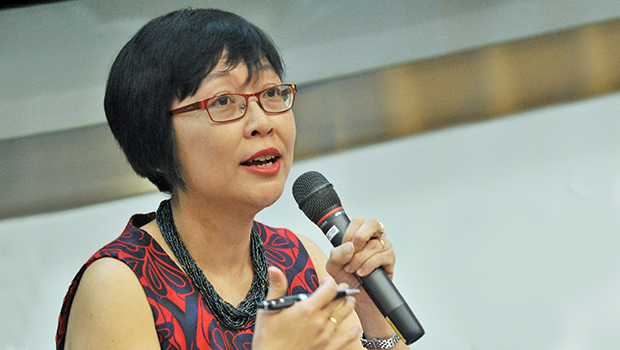
To engage patients in their own care, healthcare professionals need to step into their shoes, which means to hear what they hear, see what they see, and feel what they feel, says patient advocate Ms Ai Ling Sim-Devadas.
Healthcare communications consultant and trainer, Ms Ai Ling Sim-Devadas, does not think that everyone views patient engagement in the same light.
In her talk on “Improving Care Through Patient Engagement” at SingHealth recently, she said, “Medical professionals sometimes see it as patients complying with treatment and doing things themselves to get better. But patients see it as communication, guidance and not being treated like digits. They want their doctor to be like a ‘tour guide’ in their journey to wellness.”
This difference of perspective also extends to patient safety, she said. While healthcare professionals focus on patient safety goals, patients place importance on what affects their wellbeing. They want to know if the treatment is safe and right, and what they should do if complications arise.
Dr Kurt and Dr Kind in action
To illustrate her point she incorporated a humorous skit into the talk. Put up by members of SPAN (SingHealth Patient Advocacy Network) it starred twin brothers Dr Kurt Raju and Dr Kind Raju (played by Mr Ellil Mathiyan). They see a diabetic patient, a retired clerk living alone (played by Ms Khoo Sork Hoon). She no longer wants to take her medicines, but discusses alternative treatment with her friend (played by Ms Gracie Lim). Here’s a small excerpt.
On-the-spot survey results
An audience survey during the talk showed that many healthcare professionals feel that they are engaging patients, but patients do not feel engaged.
Ms Sim-Devadas, who also co-chairs the SingHealth Patient Advocacy Network (SPAN) interviewed SPAN patients and caregivers about their views on patient engagement.
Patients told her that they do not feel encouraged by healthcare staff to be engaged. Those who are, are doing it through their own efforts, by being proactive, asking questions and closing information gaps.
Some examples of not being engaged
She cited the case of a SPAN member, a doctor who is also a former cancer patient, who did not feel engaged. Her oncologist, in good faith, treated her like a medical professional, giving her plenty of information and three options to consider. However, in that situation, she was not a doctor but a vulnerable patient who needed guidance, not information overload. She needed a doctor she could trust to decide for her, and tell her what she could and could not do. She switched to another doctor eventually.
Another example cited was when a patient who did not feel engaged by his doctor, decided to stop his hypertension medication because he felt that he did not need it. On the contrary, an engaged patient would have shared his concerns with his doctor, and be advised on the possible health risks involved from stopping medication abruptly.
Why patients don’t get engaged
She shared that some patients may feel intimidated by clinicians, hospital staff, the healthcare system or medical jargon. They may also fear speaking up in case they are blackmarked as “difficult”.
“Being afraid is a real thing. I didn’t experience this until I became a patient. I had a fever and needed intravenous antibiotics. While setting it up, the nurse was multitasking and talking to a colleague too. I was worried whether the needle was going in properly. I kept watching her like a hawk but was too afraid to say anything.”
A mindset change is needed
She said healthcare professionals need a mindset change if they are to involve more patients in their own care.
“Workload and time constraints may make them process-oriented. They may not listen or ask enough questions. On an organisational level, there could be a lack of coordination, ignorance, pressure and a lack of time.”
They need genuine interest in their patients, good listening skills and empathy, she said. “Engaging patients is about communication and trust. To a patient, trust is supporting him through his journey, understanding his needs, and having his interest at heart. What is trust to you? How do you build that trust?”
How to improve
Here are some of her suggestions for healthcare professionals:
- Create a safe zone: Make it safe for patients to communicate with you so that they will be willing to open up to you about their care and safety concerns. Empathetic communication is key in creating the safe zone. This means being friendly, positive and showing interest. Ask open-ended questions and listen to understand and to help. Give them your undivided attention. Don’t criticise and prove them wrong. Smiling genuinely is important because when someone wears a mask, a genuine smile only comes through their eyes. Finally, show you care by acknowledging their emotions and worries when you speak to them.
- Don’t Rush: She said patients understand the problem regarding the lack of time, but she suggested looking at the quality rather than quantity of time during consultations. It is more important to patients that they are given the attention and are heard during the consultation.
- Walk in the patient’s shoes: Understand patients and what matters to them by standing in their shoes. Hear what they hear, see what they see, and feel what they feel.













 Get it on Google Play
Get it on Google Play